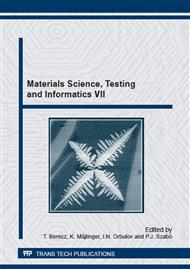p.41
p.47
p.53
p.59
p.65
p.71
p.77
p.83
p.89
Styrene-Butadiene Rubber/Graphene Nanocomposites: Effect of Co-Milling with Cyclic Butylene-Terephthalate
Abstract:
Graphene nanoplatelets (GnP) reinforced styrene-butadiene rubber (SBR) nanocomposites were produced by two different methods. For reference purpose carbon black (CB) reinforced formulations served. In the first method the components were mixed on a two roll open mill directly. In the second method, GnP was subjected to milling in an attritor mill together with cyclic butylene-terephthalate oligomer (CBT) powder prior to the mixing on two roll mill. Samples were cured in a hot press. The rubber sheets were characterized by tensile and tear tests, and their fracture surfaces inspected in scanning electron microscopy (SEM). Results showed that GnP outperformed CB with respect to reinforcing effect. Previous co-milling of GnP with CBT caused a slight decrease in mechanical properties. SEM images proved, that the co-milling process did not affect significantly the dispersion of GnP, its particles were shredded into smaller pieces, which caused the slight decrease in the mechanical properties.
Info:
Periodical:
Pages:
65-70
Citation:
Online since:
February 2015
Authors:
Keywords:
Price:
Сopyright:
© 2015 Trans Tech Publications Ltd. All Rights Reserved
Share:
Citation:



